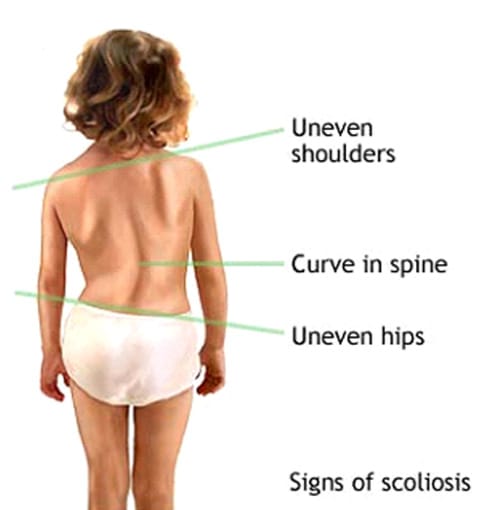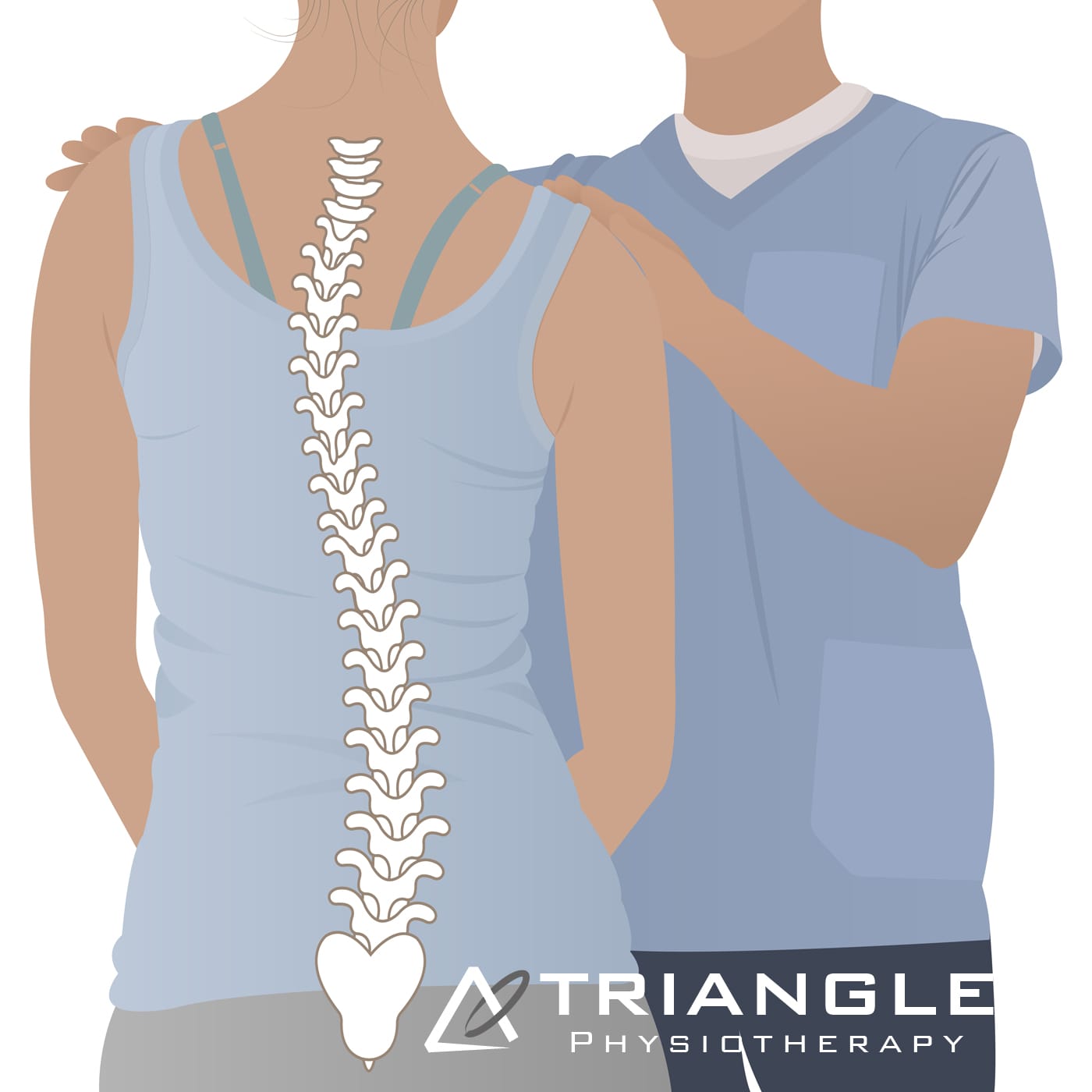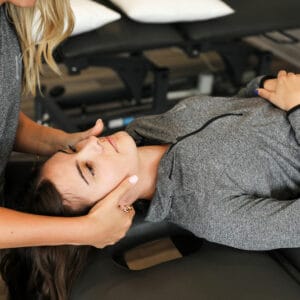Physiotherapy can play a role in managing scoliosis, but it is important to understand that it is not a cure for the condition. Scoliosis is a complex spinal deformity characterized by an abnormal curvature of the spine. The treatment of scoliosis depends on various factors, including the severity of the curvature, the age of the individual, and other medical considerations.

How do I know if I have scoliosis?
While it’s possible to have scoliosis without experiencing noticeable symptoms, there are some signs and symptoms that may indicate the presence of scoliosis.
- Uneven Shoulders: Stand in front of a mirror with your arms hanging naturally at your sides. If one shoulder appears higher than the other, it could be a sign of scoliosis.
- Uneven Hips: When standing, if one hip appears to be higher or more prominent than the other, it may be a sign of scoliosis.
- Asymmetrical Waist: An uneven waistline, where one side of the waist is higher or more pronounced than the other, can be a sign of scoliosis.
- Leaning to One Side: Some people with scoliosis may unconsciously lean to one side when standing or walking.
- Visible Spinal Curvature: In more severe cases, you or someone else may notice a visible curve or twist in the spine when looking at your back. This is often more noticeable when bending forward at the waist.
- Back Pain or Discomfort: Scoliosis can sometimes cause back pain, particularly if the curvature is significant or if it progresses rapidly.
- Clothing Fit: You may notice that your clothing doesn’t hang evenly or that one side of your shirt or dress appears longer than the other.
- Uneven Leg Length: Scoliosis can sometimes give the appearance of uneven leg lengths due to pelvic rotation caused by the spinal curvature.
How is Scoliosis diagnosed?
Scoliosis is typically diagnosed through a combination of methods, including a physical examination, medical history assessment, and imaging studies. Here is a step-by-step explanation of the diagnosis process:
- Medical History and Symptom Assessment: The first step in diagnosing scoliosis involves discussing your medical history and any symptoms you may be experiencing with a healthcare provider. They will ask about any family history of scoliosis, previous medical conditions, and any pain or discomfort you may have noticed.
- Physical Examination: A physiotherapist, will conduct a physical examination. During this examination, they will:
- Ask you to bend forward at the waist with your feet together and arms hanging down. This helps the healthcare provider assess the curvature of your spine. They will look for any asymmetry or abnormal curvature.
- Examine your back while you are standing to check for any signs of scoliosis, such as uneven shoulders, hips, or a noticeable curve in the spine.
- Measure the degree of spinal curvature using a scoliometer, a specialized instrument that quantifies the angle of spinal rotation.
- Imaging Studies: If the physical examination suggests the presence of scoliosis or if there are other concerning factors, imaging studies may be ordered to confirm the diagnosis and assess the severity of the curvature. Common imaging techniques used include:
- X-rays: X-rays provide detailed images of the spine and are used to measure the angle of the spinal curvature (Cobb angle). X-rays are essential for determining the severity of scoliosis and planning treatment.
- MRI (Magnetic Resonance Imaging): In some cases, an MRI may be recommended, especially if there are concerns about spinal cord compression or underlying spinal abnormalities. MRI provides detailed soft tissue images.
- Additional Evaluation: Depending on the findings from the physical examination and imaging studies, additional tests or evaluations may be necessary. This can include assessing lung function if the scoliosis is severe, as it can affect respiratory function in some cases.
How can physiotherapy help Scoliosis?
Physiotherapy can play a beneficial role in the management of scoliosis, particularly in helping to improve posture, reduce pain, and enhance overall function. While physiotherapy cannot cure scoliosis, it can be a valuable component of a comprehensive treatment plan. Here are ways in which physiotherapy can help individuals with scoliosis:
- Pain Management: Many individuals with scoliosis experience back pain and discomfort. Physiotherapists can employ various techniques to alleviate pain, including manual therapy, soft tissue mobilization, and modalities like heat or ice therapy.
- Postural Improvement: Physiotherapists can work with individuals to improve their posture. Proper posture can help prevent the progression of scoliosis and reduce the strain on the spine and surrounding muscles.
- Muscle Strengthening: Specific exercises are prescribed to strengthen the muscles around the spine. Strengthening these muscles can provide better support for the spine and potentially help improve spinal alignment.
- Range of Motion: Physiotherapy can help maintain or improve the range of motion in the spine and other affected joints. This is important for overall mobility and function.
- Breathing Exercises: In cases where scoliosis affects respiratory function, physiotherapists can teach breathing exercises to improve lung capacity and respiratory function.
- Core Stability: Core strengthening exercises can enhance the stability of the spine and help individuals maintain better posture.
- Patient Education: Physiotherapists can educate individuals with scoliosis on their condition, treatment options, and self-management techniques. This education empowers individuals to take an active role in their care.
- Bracing Support: For individuals prescribed with a brace to manage scoliosis, physiotherapists can provide guidance on wearing and adjusting the brace properly to achieve the best results.
- Emotional Support: Coping with scoliosis, especially during adolescence, can be emotionally challenging. Physiotherapists can provide emotional support and help individuals develop a positive body image and self-esteem.
- Collaboration with Other Healthcare Providers: Physiotherapists often work as part of a multidisciplinary team that includes orthopedic surgeons, chiropractors, and other healthcare professionals. They collaborate to ensure comprehensive care for individuals with scoliosis.
How do I book an appointment at a Physiotherapy Clinic near me?
Click HERE to book an appointment with a physiotherapist or chiropractor at one of our eight locations.
- Physiotherapy Etobicoke – Triangle Physiotherapy Etobicoke
- Oakville Physiotherapy Clinic – Triangle Physiotherapy Oakville
- Physiotherapy North York – Triangle Physiotherapy North York
- Mississauga Physiotherapy Clinics – Triangle Physiotherapy Mississauga
- Downtown Physiotherapy Clinics – Triangle Physiotherapy King West
- Uptown Physiotherapy Clinics – Triangle Physiotherapy Lawrence Park
- Physiotherapy Clinic Downtown Toronto – Triangle Physiotherapy Queens Quay
- Physiotherapy Clinics Mississauga – Triangle Physiotherapy Erin Mills
“Scoliosis can be managed effectively with the right physiotherapy approach. Triangle Physiotherapy offers expert services across the GTA, including Physiotherapy in Etobicoke, Oakville, North York, Toronto, Lawrence Park, Queens Quay, Erin Mills, Mississauga, and Liberty Village. Our experienced physiotherapists can help you develop a personalized treatment plan to manage scoliosis and improve your quality of life.”




